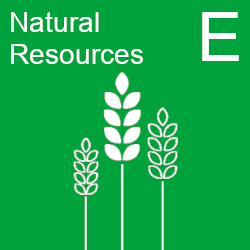Notice: From 01 December 2025, the Outcome Indicator Framework dashboard has been moved. Future updates to this publication are available on GOV.UK at: Environmental Indicator Framework.
Short Description
Total Factor Productivity is a well-established index of how efficiently farming inputs (such as fertilisers, labour) are converted into outputs (such as wheat, milk) giving an indication of changes in the efficiency and competitiveness of the agriculture industry. It is based on the ratio of inputs (indicator ‘E3 Volume of inputs used in agricultural production’) to outputs (indicator ‘E2 Volume of agricultural production’) such that the higher the value, the more efficiently inputs are converted into outputs. Data are based on volumes rather than values so that price effects are removed. The measure is known as Total Factor Productivity as it takes into account all output and input factors, including land, labour, intermediate consumption and depreciation of capital.
Readiness and links to data
The data presented in this indicator are derived from the official statistics on total factor productivity for England by farm type. These Total Factor Productivity data are collated via the Farm Business Survey and are updated annually.
Indicator components
Figure E4: Efficiency of agricultural production measured by Total Factor Productivity, England, 1990/1991 to 2023/2024
Table E4: Efficiency of agricultural production measured by Total Factor Productivity, England, 1990/1991 to 2023/2024
| Year | Total factor productivity | Volume of agricultural production | Volume of inputs used in agricultural production |
|---|---|---|---|
| 1990/1991 | 100.00 | 100.00 | 100.00 |
| 1991/1992 | 103.06 | 103.56 | 100.48 |
| 1992/1993 | 104.64 | 98.85 | 94.46 |
| 1993/1994 | 98.98 | 93.73 | 94.70 |
| 1994/1995 | 99.43 | 94.72 | 95.26 |
| 1995/1996 | 102.10 | 100.62 | 98.55 |
| 1996/1997 | 103.82 | 101.77 | 98.02 |
| 1997/1998 | 105.19 | 101.51 | 96.50 |
| 1998/1999 | 105.39 | 100.23 | 95.11 |
| 1999/2000 | 109.33 | 101.20 | 92.57 |
| 2000/2001 | 107.96 | 91.79 | 85.02 |
| 2001/2002 | 106.91 | 100.20 | 93.72 |
| 2002/2003 | 116.11 | 106.01 | 91.30 |
| 2003/2004 | 119.01 | 107.90 | 90.67 |
| 2004/2005 | 123.99 | 108.95 | 87.87 |
| 2005/2006 | 125.24 | 106.60 | 85.12 |
| 2006/2007 | 124.27 | 104.91 | 84.42 |
| 2007/2008 | 116.43 | 99.58 | 85.53 |
| 2008/2009 | 123.64 | 105.05 | 84.97 |
| 2009/2010 | 115.44 | 100.77 | 87.29 |
| 2010/2011 | 113.41 | 99.84 | 88.04 |
| 2011/2012 | 121.46 | 103.66 | 85.35 |
| 2012/2013 | 107.93 | 95.06 | 88.08 |
| 2013/2014 | 110.95 | 98.58 | 88.86 |
| 2014/2015 | 115.03 | 105.14 | 91.40 |
| 2015/2016 | 118.51 | 106.50 | 89.87 |
| 2016/2017 | 112.82 | 102.06 | 90.47 |
| 2017/2018 | 118.84 | 104.10 | 87.60 |
| 2018/2019 | 117.42 | 107.18 | 91.28 |
| 2019/2020 | 121.66 | 110.36 | 90.71 |
| 2020/2021 | 116.30 | 102.21 | 87.88 |
| 2021/2022 | 123.48 | 103.18 | 83.55 |
| 2022/2023 | 130.82 | 106.66 | 81.53 |
| 2023/2024 | 120.06 | 102.43 | 85.32 |
Trend description for E4
Overall productivity is driven by both the output and input components. Total Factor Productivity of the agricultural industry in England was 20.1% higher in 2023/2024 than it was in 1990/1991. This overall long-term increase has been driven by both increased outputs and a fall in inputs, although the separate trends (see indicators E2 and E3) have followed different patterns. There is considerable annual variation, driven mainly by variation in output volumes. More recently, following an increase from 2021/2022 to an all-time high in 2022/2023, Total Factor Productivity of the agricultural industry in the UK fell by 8.2% in 2023/2024.
Assessment of change
An increase in efficiency of agricultural production as measured by Total Factor Productivity has been observed over the short-, medium- and long-term assessment periods. However, it is not possible to simplistically categorise any change as either an ‘improvement’ or ‘deterioration’ for the environment as this will depend on the farming practices driving change.
Change since 2018 has also been assessed. There has been an increase in efficiency of agricultural production measured by Total Factor Productivity since 2018.
Further information on this assessment, along with details on the methodology, is provided in the Assessment background page. Summaries by 25 Year Environment Plan goal and information on indicator links are presented in the Assessment results pages
Table E4: Assessment of change
| Component | Subcomponent | Period | Date range | Percentage change | Smoothing function | Assessment of change |
|---|---|---|---|---|---|---|
| E4 | Total factor productivity | Short term | 2018/2019 to 2023/2024 | 6.91 | Loess | Change (increasing) |
| E4 | Total factor productivity | Medium term | 2013/2014 to 2023/2024 | 9.22 | Loess | Change (increasing) |
| E4 | Total factor productivity | Long term | 1990/1991 to 2023/2024 | 26.40 | Loess | Change (increasing) |
Note that assessment categories were assigned based on smoothed data, so percentage change figures in Table E4 may differ from unsmoothed values quoted elsewhere. It is not possible to define a simplistic desired direction of change for this indicator so we cannot assign an ‘improvement’ or ‘deterioration’ label to these results.

